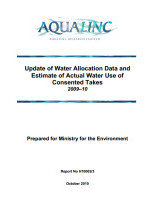This report presents a summary of the regional council consent data for water takes between 2009 to 2010. The information in the report has been used to update the freshwater demand environmental indicator.
This report presents a summary of the regional council consent data for water takes between 2009 to 2010. The information in the report has been used to update the freshwater demand environmental indicator.
Key findings
- There are over 20,500 resource consents for taking fresh water, compared to 20,000 in 2006. Just over two-thirds of these consents are to take groundwater and just under one-third are to take surface water.
- Although there are more consents for groundwater, four times more water is consented to be taken from surface water than from groundwater.
- Irrigation and hydro-generation account for the majority of consumptive (water not returned to source) weekly allocations with 46 per cent and 41 per cent respectively.
- Most hydro-generation takes in New Zealand return the water from where it came, however one hydro-generation take in Southland discharges to sea, preventing others from using the water. This one abstraction is consented to take over 40 per cent of the total weekly consumptive allocation nationally.
- The total annual allocated consumptive volume (27 Bm3/year) in New Zealand is equivalent to almost half the volume of Lake Taupo and over three times the volume of Lake Taupo when non-consumptive takes (like all hydro-generation) are also included (193 Bm3/year).
- Peak water allocation pressure occurs during summer when consents for irrigation are active. The total weekly allocated volume (757 Mm3/week) in New Zealand is sufficient to fill up 30 Olympic-sized swimming pools every minute.
- Canterbury, Southland and Otago account for 86 per cent of the total weekly allocated volume in New Zealand, emphasising that where it occurs, allocation pressure is generally a regional rather than national issue.
- Weekly allocation has increased by a third since 1999, including the Southland hydro take. Excluding this hydro take, allocation has nearly doubled since 1999, and increased by 10 per cent in the past four years.
- The estimated actual water used compared to the maximum consented volume in New Zealand is 65 per cent.
- Most regions use less than 50 per cent of the consented water indicating that there are opportunities for water to be more efficiently utilised in some regions.
